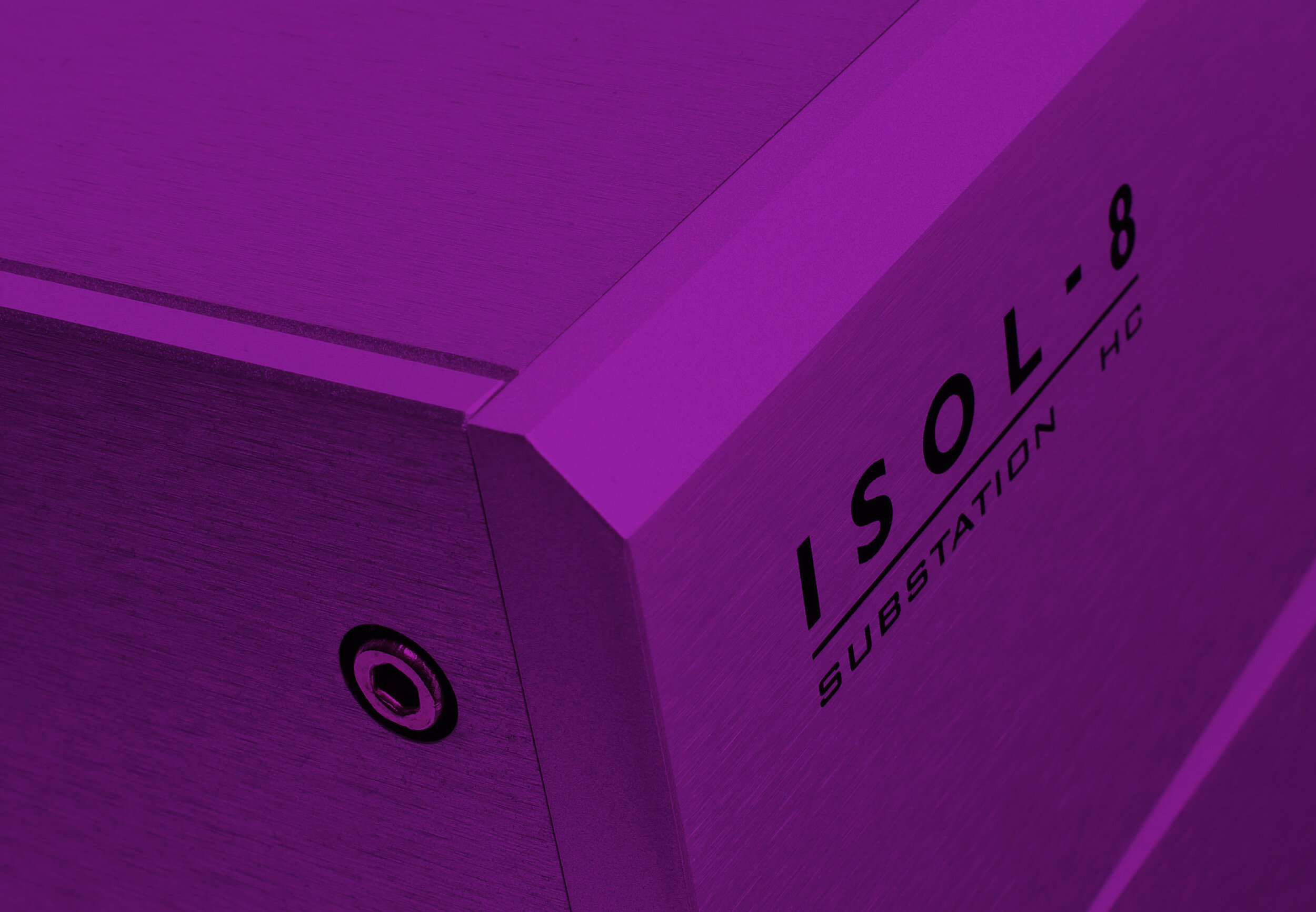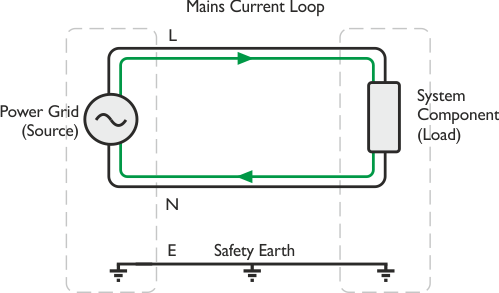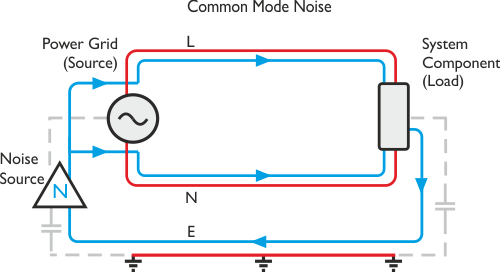
Types of Noise
There are many forms of noise that a Hi-Fi or AV system can be subject to or even produce.
If the actual pieces of equipment are buzzing this is generally one or more of the following:
poor transformer design or construction
Use of a product not designed for the users' power line frequency
Poor mechanical mounting of the product
An over-voltage mains supply
A significantly distorted mains supply
DC present on the mains supply
If there is noise from the speakers then it may be one or more of the following:
Poor noise performance of one or more of the pieces of equipment
Incorrectly matched sensitivities between products (e.g. power amp too sensitive for a pre-amp, speakers too efficient for a power amp)
Under voltage supply (may cause regulators within a product to drop out of regulation)
Earth grounding loops
No earth
Poor or high impedance earth
Significant distortion of the mains supply
Significant mains born or environmental RF present
Significant electromagnetic field present, which can effect the equipment or the cabling.
All ISOL-8 mains filters act to reduce mains-born wide-spectrum noise. The frequency and degree of attenuation depends on the model; each ISOL-8 unit delivering better results as one progresses up the range. In addition, ISOL-8 models with Axis technology stop DC from passing to the connected equipment. Only complete regeneration can provide an absolutely pure waveform, devoid of any aberrations.
It must be remembered that much of the acoustic improvements that mains filtering bring about is due to what we don't actually hear. No piece of equipment is perfect and even a small amount of mains born energy other than the 50 or 60Hz fundamental can have a significant deleterious effect on how the equipment handles the actual audio (or video) signal passing through it. This is particularly significant with 'high gain' kit where there is only a millivolt signal level to begin with.
Why Condition your Mains Supply?
The purpose of any high fidelity system is to take you as close as possible to the original performance. We strive to reduce the compromises involved and get closer to the emotion, closer to the music.
Each component in our system is an imperfect link in a chain, transforming the energy it receives from one form to another and eventually on to us.
The most fundamental, most overlooked link in the chain is the power supply, the source of our systems energy. We plug into the wall, the device works and we take it for granted. Mains power is in fact the start of the chain, the very foundation on which the music is built and is worthy of greater scrutiny.
The Problem.
Taking a closer look at the mains reveals it is not a simple issue and it is often not what we may expect. Zoom in on an AC mains cycle and how it is used reveals there is a lot going on: Power is not universally used in a linear, electrically benign way. Pollution and distortion of our energy supply is an inevitable consequence of its use and it is everywhere.
Countless electrical appliances in homes and in industry across our locality are consuming power constantly. Each turns some of the energy it uses into noise: either as radio interference or distortion of the mains itself. All are connected to and share the same physical conduit: the power grid. The grid was conceived and implemented with little regard to noise transmission or immunity. So, as we all share the supply, we all share the pollution.
Most Audio Visual equipment is surprisingly vulnerable to this pollution. Limitations in the component parts commonly used in manufacture means the interference is passed through the component and on to the sensitive circuits beyond, compromising performance.
This degradation can take many forms, interactions between the interference and the equipment are varied and unpredictable. Radio frequency noise from digital devices can transform itself into distortion in the silicon junction of any transistor. High energy spikes from switch contact arcing causes clicks, Broadband noise from rectifier diodes can create a haze veiling detail and industrial inductive loads can cause significant local distortion of the mains waveform. These effects are often the reason why your system sounds better at night, when there is less local electrical activity.
It is not a trivial problem and worse is to come. With the advent of wireless digital network technology such as Bluetooth and WiFi replacing cable transmission, and the growing wide scale use of electrically noisy switched-mode power supplies, the quantity of local mains and radio pollution is set to mushroom.
There is also the enemy within: Each component operating in a system also generates significant quantities of noise itself. Because of its electrical proximity to other components in the system, taking measures against the effects of the outside world is not enough to release all the potential in your system. Preventing noise from one appliance from cross contaminating other components in the system is as important as protecting the system as a whole. This is important fact is often overlooked and is why we recommend each system component is considered separately to eliminate this effect.
The Solution.
Removing mains borne noise can dramatically improve your system. A carefully designed filter or regenerator, isolating each individual component in your system, will provide superior, more predictable performance. The benefits are often not subtle. Other solutions such as specialist mains cables, which often provide improvements due to a limited degree of filtering as a consequence of their physical geometry are usually unpredictable. Tackling the source of the problem is a more powerful tool than just coping with its effects.
Optimising power supply and eliminating supply transmitted noise is probably the most cost effective upgrade you can make, typically bringing improvements in focus, contrast, timing, resolution, consistency and most importantly: involvement.
Contact us, or visit one of our dealers, to learn how much you stand to gain by taking a closer look at your power supply.
Cross Contamination Explained.
The problem of noise cross contamination through power supply is often overlooked. Reducing its effect can result in significant performance gains for any system.
The key point is to understand is that each system component is not blameless and generates significant mains noise itself. In terms of power supply, it is also usually in close proximity to other components in the system, compounding the problem.
If you have system that contains a single component, one filter will protect it from mains borne noise:
Despite the presence of the filter, adding other components still allows noise to circulate in the system. Any noise generated within the system passes from one system component to another as they are all connected to each other in parallel after the filter. The presence of the filter will have an effect on this transmission, but it is far from the optimum solution.
A multiple filter configuration, as pioneered by ISOL-8's designer Nic Poulson, is the optimum solution. External noise is blocked as before. But significantly, each component is also prevented from influencing the performance of another, releasing maximum performance.
DC on the Mains.
Power supplies in Hi-Fi and AV equipment often assume connection to a perfect mains supply. In theory the mains waveform should be pure AC: a perfect, symmetrical sine wave.
Many of the myriad appliances connected to the supply, at home and in industry; from electronic dimmers to computer power supplies, use the AC energy available in a mains cycle unevenly. The net result is the effective addition of DC to the mains network.
This effect is inevitable and also inherently unpredictable. In practice the waveform can arrive at the end-user clipped, distorted and asymmetric. Simplistic analyses of unmatched peak voltages are not the whole story: Any AC waveform which does not have equal energy in both positive and negative phases will contain a DC component; regardless of what the peak voltages are or what the wave shape is.
The AC transformers commonly found in audio equipment cannot, by nature, tolerate significant DC without being compromised.
As all transformers convert power through the medium of magnetism, any DC present will inhibit its capacity to transform AC by partially or completely saturating the magnetic circuit. It is this vulnerability to DC that causes acoustic hum and significantly reduces the transformer's power capacity. Even measured at comparatively low levels we have found that this has a significant negative impact on the following power supply and circuit performance, which in turn can degrade sound quality.
The graph below is an illustration of an imperfect mains waveform before processing by the Axis circuit:
The ISOL-8 Axis circuit re-balances the energy axis of the mains waveform without restricting the effective current capacity. This eliminates any DC voltage on the mains power supply, suppressing acoustic hum and liberating system performance.
Waveform after processing by the Axis circuit:
Transmodal Technology
In order to understand ISOL-8 Transmodal technology, it is necessary to visit some basic fundamentals of filters in power applications. We have simplified the information below as far as possible for clarity.
When an electrical load is connected to a source a current loop is formed. Transfer of energy takes place as current flows from the source through the load and returns to the source. Electricity makes no distinction between mains power or performance degrading noise. It is all the same to any connected circuit.
Noise can enter any current loop in a number of ways, but can be largely categorised into two types or modes.
Firstly we’ll look at Differential Mode Noise. This occurs when only one conductor of a current loop encounters a noise source. The noise therefore circulates within the loop. For example this occurs when conductors are not closely coupled; such as in equipment internal wiring or when the noise is generated from circuit elements within the load or source itself.
Secondly we’ll look at Common Mode Noise. This occurs in both conductors of a current loop; equally and in phase with respect to ground. An instance being closely coupled live and neutral conductors encountering an electromagnetic field that immerses both conductors equally. For example; a cable picking up transmitted radio energy, from broadcast or wi-fi transmitters for example. The noise has its own current loop and returns through the safety earth conductor via the stray capacitance present in all distributed electrical systems.
Both these types of noise are commonly found in the real world. Now let’s look at how to reduce the unwanted noise entering the load. With Common Mode Noise a filter can be readily designed to attenuate the energy down to a given frequency using a common mode inductor. This uses phase cancellation to attenuate unwanted noise. The physical geometry of the inductor produces a relatively large value of inductance, given the core size and number of wire turns. It therefore produces effective filtering but for common noise only. Differential mode noise is able to pass through the filter readily.
A different topology is needed to attenuate Differential Mode noise. In this case only separate series inductors in the send (live) and return (neutral) in combination with a shunt capacitor in the current loop can attenuate the noise. Unfortunately the favourable geometry of the common mode inductor is not effective in this case. The series inductors used in the filter must use larger cores and more turns of wire to provide effective attenuation for differential mode noise compared with common mode.
Inferior mains conditioners may claim they filter differential mode noise but in fact use shunt elements without series inductors to divert the noise to earth (known as a Delta configuration). This then pollutes the earth instead, not the optimum solution for sensitive audio equipment as noise is still present on the earth line.
ISOL-8 Transmodal Filter: Warning! All mains conditioning is not created equal. Most manufacturers of mains conditioning equipment completely fail to effectively filter differential mode noise as it adds both complexity and cost. ISOL-8 Transmodal filters combat both common and differential modes of transmitted noise whilst keeping the earth clean for maximum filter performance at all times.
“Optimising
power supply
and eliminating
supply transmitted
noise is probably
the most cost
effective upgrade
you can make...”
NIC POULSoN | ISOL-8













